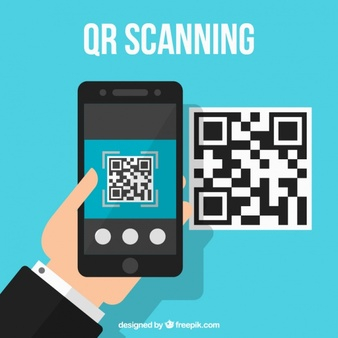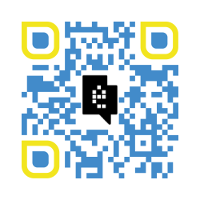QR (Quick Response) codes are those small icons consisting of an array of black and white squares and are used for storing small amounts of information or more frequently URLs.
They are easily readable using a smart-phone camera and a dedicated application and there are dozens of free applications to chose from.

The usage of QR codes as a marketing and information quick access tool had risen and fallen a few times in the latest years with huge variations depending on the specific country, for example it is hugely popular in China while its usage in Europe has been consistently low.
For marketers the feel is that of a tool with great unrealized potential.
In 2017 QR codes were back in fashion with Apple installing an active QR code reader in the native camera application of its phones. The increased penetration of smartphones with QR codes readers pre-installed could really be the turning points for QR codes to achieve a huge success (again).
As Juniper Research Analyst Lauren Foye pointed out: “Apple’s addition of QR code reading facilities directly addresses a major barrier for use in Western markets. The lack of an in-built reader had been a hindrance, with consumers needing to download a separate QR code scanner app”.
QR codes usage research also shows that numbers are growing with 34% of US smart-phone users and 46% of tablet users having scanned at least 1 QR code according to data by Juniper Research; the use of QR code coupons is also predicted to rise from 1.3 billion in 2017 to 5.3 billion in 2022, driven by new scanning and camera features.
- QR coupons redeemed via mobile will reach 5.3 billion by 2022.
- Coded coupons redeemed via mobile in 2017 approached about 1.3 billion.
- Over 1 billion mobile devices will access coupons through QR codes by 2022.
Examples of how a QR code could be used include :
- Offer coupons/discounts
- Start a call with the Customer service
- Lead to the eCommerce page
- Link to sites/social accounts
- Give extra content
- App downloads
- Click to quickly pay
- Direct to a contest landing page
- Direct to subscriptions
Overall QR codes can dramatically improve the digital experience around a product or a service and this can often lead to additional purchases and revenues.
QR codes use in the healthcare
QR codes are just starting to be used in the healthcare sector, with usage guidelines now being set by both EMA and the FDA. Current use cases are limited to the use of a QR code on a product packaging to enable a number of information access services like, for example:
- downloading the latest (digital) version of the Patient Information leaflet
- accessing documents related to medical products (related studies and Public Assessments Reviews)
- linking to a website with patient generated data (health/patients blogs)
- linking to an online medical consultation
- linking to a video explaining how to use/clean/prime a product
- collecting Adverse Reaction Information from users
- engaging customers through marketing initiatives
The overall strategy in this case is to provide easy access to up-to-date information which ultimately can help users, patients and professionals use or prescribe a product in a safer way.
EMA Guidelines on the use of QR codes
Since 2015 the European Medicines Agency has issued a number of guidelines to regulate the use of QR Codes on the medicinal products packaging.
These are the top 8 Highlights from the EMA Guidelines:
-
Pharma companies can add a QR Code to the packaging material or package leaflet of centrally authorised medicinal products as long as the linked information is useful to the patient and not promotional in any way.
-
Pharma companies should inform the EMA of their intention to use QR Codes via a request, which can be made as part of the initial marketing authorisation application (pre-authorisation) or after the medicinal product is authorised.
-
A completed request/declaration form needs to be submitted to the EMA along with relevant information such as linked content, labelling mock-ups, and location of the QR Code.
-
The QR Code can contain any information that is relevant to the patient and the product, and can be in the form of a website, web page, PDF document, video, or link to a mobile application. The information in the QR Code cannot be promotional.
-
The information linked with the QR Code should be ‘additional’ information to patients and health care professionals and should not replace important statutory information such as the printed package leaflet.
-
The location of the QR Code should not affect the readability of statutory information. Inclusion of several QR Codes on a single package in not recommended.
-
The QR Code should be made available in all the Member States where the medicinal product is marketed and the information should be available in all the EU official languages of those Member States.
-
Patients should have the option of either scanning a QR Code via a smartphone or entering a customised short URL in a web browser.
The full guidelines document is available on the EMA website
The eLeaflet + QR code solution from myHealthbox
Most healthcare companies struggle to negotiate between the digital innovation which is now permeating the healthcare sector and the demands of a strictly regulated environment.
When dealing with digital information and a QR-code implementation the eLeaflet solution from myHealthbox offers a fully compliant, cloud based service which is feature rich and quick to implement.
The eLeaflet is a new digital information leaflet format developed specifically for the healthcare with native support for QR-code access.
We aim to change digital communication in the healthcare, ask us how we can help you Contact us
